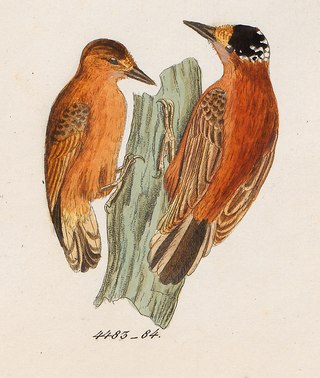
The Venezuelan flycatcher is a passerine bird in the tyrant flycatcher family. It was formerly considered to be a race of the short-crested flycatcher, Myiarchus ferox, but the two species overlap without interbreeding in Venezuela, and the calls are different.

The Venezuelan flowerpiercer is a species of bird in the family Thraupidae. It is endemic to Venezuela.

The chestnut piculet is a species of bird in subfamily Picumninae of the woodpecker family Picidae. It is found in Colombia and Venezuela.
Juglans venezuelensis, or nogal de Caracas, is a species of black walnut endemic to Venezuela. It is a small tree which bears 1 inch nuts.

Bothrops venezuelensis, or the Venezuelan lancehead, is a species of venomous snake in the family Viperidae. It is endemic to South America.
Caiman venezuelensis is an extinct species of caiman that lived in South America during the Pleistocene. The holotype of C. venezuelensis — OR-1677, a partial left premaxilla bone — was discovered in the locality of El Breal of Orocual, in the Mesa Formation, in the state of Monagas, Venezuela, the country of which derives their species name.
Hymenocallis venezuelensis is a bulb-forming herb native to Venezuela but naturalized in parts of Peru. Type location is near Guarico. Camaguan, Venezuela.
Mimasyngenes is a genus of longhorn beetles of the subfamily Lamiinae, containing the following species:
Nematolampas venezuelensis is a squid small in size (58–88mm). This squid can be found in tropical waters off the coast of Venezuela in the Caribbean Sea, Western North Atlantic. The data for this species has been gathered from four immature squids captured in the tropical waters off the coast of Venezuela in the Caribbean Sea, Western North Atlantic.
Mimasyngenes icuapara is a species of beetle in the family Cerambycidae. It was described by Galileo and Martins in 1996. It is known from Argentina and Brazil.
Mimasyngenes lucianae is a species of beetle in the family Cerambycidae. It was described by Galileo and Martins in 2003. It is known from Brazil.
Mimasyngenes quiuira is a species of beetle in the family Cerambycidae. It was described by Galileo and Martins in 1996. It is known from Brazil.
Mimasyngenes ytu is a species of beetle in the family Cerambycidae. It was described by Galileo and Martins in 1996. It is known from Brazil.
Mimasyngenes murutinga is a species of beetle in the family Cerambycidae. It was described by Martins and Galileo in 2006. It is known from western Ecuador.
Mimasyngenes inlineatus is a species of beetle in the family Cerambycidae. It was described by Stephan von Breuning in 1956. It is known from Colombia and Venezuela.
Mimasyngenes lineatipennis is a species of beetle in the family Cerambycidae. It was described by Stephan von Breuning in 1950. This species can be found in Argentina and Brazil.
Mimasyngenes lepidotus is a species of beetle in the family Cerambycidae. It was described by Clarke in 2007. It is known from Bolivia.
Mimasyngenes multisetosus is a species of beetle in the family Cerambycidae. It was described by Clarke in 2007. It is known from Bolivia.
Aspergillus venezuelensis is a species of fungus in the genus Aspergillus. It is from the Nidulantes section. The species was first described in 2004. It has been shown to produce aflatoxin B1 and sterigmatocystin.
Bairdemys is an extinct genus of side-necked turtles in the family Podocnemididae. The genus existed from the Late Oligocene to Late Miocene and its fossils have been found in South Carolina, Puerto Rico, Panama and Venezuela. The genus was described in 2002 by Gaffney & Wood and the type species is B. hartsteini.


